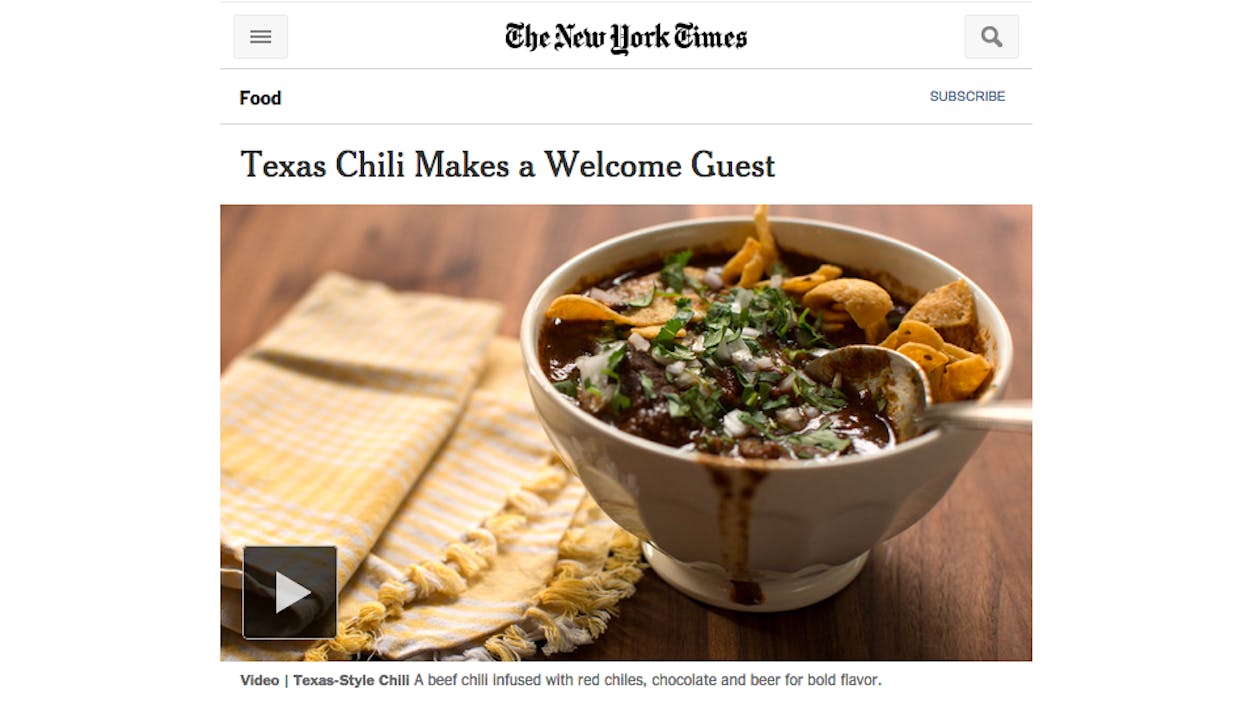Well, at least it doesn’t have beans in it.
That was Brennan’s-trained Houston chef (and native son) Randy Evans’s first reaction on scanning over the “Texas chili” recipe in today’s New York Times, one purportedly handed over to writer Julia Moskin—who is co-authoring an upcoming chili cookbook with veteran Texas food sage Robb Walsh, a former co-worker of mine at the Houston Press and Houstonia Magazine—by someone described only as “a native of Austin.”
“Usually when it’s someone from New York talking about chili, the first they they say is ‘It has to have beans in it,’” Evans said. “I was happy that at least this one doesn’t.”
Two ingredients in the mix definitely did catch his attention though: toasted coriander seeds and an ounce of unsweetened chocolate. (Cue the old Pace Picante cowboys…)

“That was what I thought was the craziest. I’ve never put chocolate or coriander in chili,” Evans says. “[Chili] has cumin, chili powder, onions, garlic, a little bit of tomato paste, and I put masa in mine. That’s my thing. But chocolate? That’s mole! And coriander? I’ve never seen coriander seeds put in chili, ever.”
Those ingredients also strike our own food editor, Patricia Sharpe, as more than a little odd for a Texas chili. “With the whole chilis, and the whole coriander seeds and the chocolate, and toasting the spices in a skillet or a comal, it definitely goes in a more Mexican direction. If they had tailgate parties in Mexico, this would be great, but this is not Texas chili.”
Evans agrees. At Haven, his critically-acclaimed though now-closed restaurant, the wild boar chili was one of the signature dishes, and once listed as one of the five best bowls in Houston.
“And that”—coriander, chocolate—“was never something that we did. Chocolate and coriander, when I read that I was just like ‘Really?’”
Robb Walsh, Moskin’s co-author, contends that coriander is an authentic chili ingredient, that it was brought to San Antonio along with cumin by that city’s famous influx of Canary Islanders in the eighteenth century.
It seems odd, then, that if it were present in the Queen City of Texas Chili’s earliest recipes, that it would be so rare now, while cumin remains a defining component. Evans says his recipe flows from those of the San Antonio Chili Queens. “Their con carne thing, with the coarse-grind. The grinding plate I used was kidney bean-shaped, so it was a larger grind, never fine-ground,” he says.
Moskin contends that the only possibly authentic Texas garnish for chili is saltine crackers. Evans takes exception to that too. “Typically I like a little bit of crema—Mexican-style sour cream—on mine, a little cheese, and really fine minced onion. That’s about all I need. And I like a little cornbread with it, triangles of it that are kind of crunchy on the side. It almost becomes a saltine. Saltines are an okay filler, but I am a cornbread guy I guess. Saltines are what you get with the greasy chili at the diner, to soak up all the grease from the bad chili.”
Evans’s verdict on the New York Times’ “Texas chili”?
It seems an interesting stew, but Texas chili it ain’t. “This is not the kind of chili I would want to eat a big heaping bowl of,” he says.
Sharpe recommends the Texas chili recipe in Texas Cowboy Cooking, by Tom Perini, the chuckwagon cuisine maestro and 33-year owner-operator of the Perini Ranch Steakhouse in Buffalo Gap.
Here is a list of more than 20 prize-winning recipes from the Terlingua International Chili Championship.
And here is Lady Bird Johnson’s recipe for Pedernales River Chili, chocolate- and coriander-free:

(Photos: Bowl of Chili: Agentseven at en.wikipedia; Chef Randy Evans: Southern Sons Consulting Facebook; Recipe: LBJ Library)







